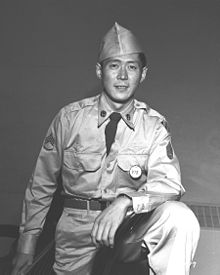Hiroshi Miyamura
Hiroshi H. Miyamura | |
|---|---|
 Miyamura as a staff sergeant | |
| Nickname(s) | Hershey |
| Born | October 6, 1925 Gallup, New Mexico |
| Allegiance | United States of America |
| Service/ | United States Army |
| Years of service | 1944–1953 |
| Rank | Staff Sergeant (highest held) Honorary Sergeant Major of the 7th Regiment[citation needed] |
| Unit | Company H, 7th Infantry Regiment 442nd Infantry Regiment |
| Battles/wars | World War II Korean War |
| Awards | Medal of Honor Meritorious Service Medal Purple Heart Prisoner of War Medal Combat Infantryman Badge |
| Other work | Automobile Mechanic and Service Station Owner |
Hiroshi H. "Hershey" Miyamura (born in Gallup, New Mexico on October 6, 1925) is a former United States Army soldier and a recipient of the U.S. military's highest decoration, the Medal of Honor, for his actions in the Korean War.
Military service

World War II
Miyamura was drafted into the Army in 1944, near the end of World War II. He served briefly with the 442nd Infantry Regiment, a famous Japanese-American unit, and was discharged from the active army shortly after Japan surrendered. Following the war, he enlisted in the U.S. Army Reserve, and was recalled to active duty following the start of the Korean War.
Korean War
He was awarded the medal for his actions on April 24–25, 1951, near Taejon-ni, Korea, while serving as a corporal in the 7th Infantry Regiment, 3rd Infantry Division. His was the first Medal of Honor to be classified Top Secret. Miyamura was captured by the North Koreans and held as a prisoner of war immediately after the actions that led to his award. As Brigadier General Ralph Osborne explained to Miyamura and a group of reporters upon notifying them of his medal, "If the Reds knew what he had done to a good number of their soldiers just before he was taken prisoner, they might have taken revenge on this young man. He might not have come back." Following his release on August 20, 1953, he was repatriated to the United States and honorably discharged from the military shortly thereafter. His medal was presented to him by President Dwight D. Eisenhower in October 1953 at the White House.
Personal life
This section needs expansion. You can help by adding to it. (December 2009) |
Miyamura is married to the former Terry Tsuchimori, who was held in the Japanese American internment camps during World War II. He has three children and four grandchildren, with one grandchild, Marisa, an officer in the United States Air Force. He has resided in Gallup, New Mexico, since his discharge from the army, where he established a career as an automobile mechanic and service station owner.[citation needed] Mr. Miyamura remains active in supporting fellow veterans including work with the Wounded Warrior Project.
Honors

On November 12, 2007, Gallup McKinley County Public Schools named their former Gallup Junior High school after Hiroshi, Miyamura High School.
Medal of Honor citation
Rank and organization: Corporal, U.S. Army, Company H, 7th Infantry Regiment, 3rd Infantry Division
Place and date: Near Taejon-ni, Korea, April 24, and April 25, 1951
Entered service at: Gallup, N. Mex. Birth: Gallup, New Mexico
G.O. No.: 85, November 4, 1953.
Citation:
Cpl. Miyamura, a member of Company H, distinguished himself by conspicuous gallantry and intrepidity above and beyond the call of duty in action against the enemy. On the night of 24 April, Company H was occupying a defensive position when the enemy fanatically attacked threatening to overrun the position. Cpl. Miyamura, a machinegun squad leader, aware of the imminent danger to his men unhesitatingly jumped from his shelter wielding his bayonet in close hand-to-hand combat killing approximately 10 of the enemy. Returning to his position, he administered first aid to the wounded and directed their evacuation. As another savage assault hit the line, he manned his machinegun and delivered withering fire until his ammunition was expended. He ordered the squad to withdraw while he stayed behind to render the gun inoperative. He then bayoneted his way through infiltrated enemy soldiers to a second gun emplacement and assisted in its operation. When the intensity of the attack necessitated the withdrawal of the company Cpl. Miyamura ordered his men to fall back while he remained to cover their movement. He killed more than 50 of the enemy before his ammunition was depleted and he was severely wounded. He maintained his magnificent stand despite his painful wounds, continuing to repel the attack until his position was overrun. When last seen he was fighting ferociously against an overwhelming number of enemy soldiers. Cpl. Miyamura's indomitable heroism and consummate devotion to duty reflect the utmost glory on himself and uphold the illustrious traditions on the military service.[1]
See also
References
 This article incorporates public domain material from websites or documents of the United States Army Center of Military History.
This article incorporates public domain material from websites or documents of the United States Army Center of Military History.
- ^ ""HIROSHI H. MIYAMURA" entry". Medal of Honor recipients: Korean War. United States Army Center of Military History. June 8, 2009. Retrieved 2007-12-30.
- "Armed Forces Information Services news article April 24, 2001, By Spc. Eric S. Bartelt". Retrieved October 5, 2010.
External links
![]() Media related to Hiroshi H. Miaymura at Wikimedia Commons
Media related to Hiroshi H. Miaymura at Wikimedia Commons
- "Home of Heros profile". Retrieved October 5, 2010.
- 1925 births
- Living people
- People from Gallup, New Mexico
- American people of Japanese descent
- United States Army soldiers
- American military personnel of Japanese descent
- American military personnel of World War II
- American military personnel of the Korean War
- Korean War prisoners of war
- Army Medal of Honor recipients
- Recipients of the Purple Heart medal
- American prisoners of war
